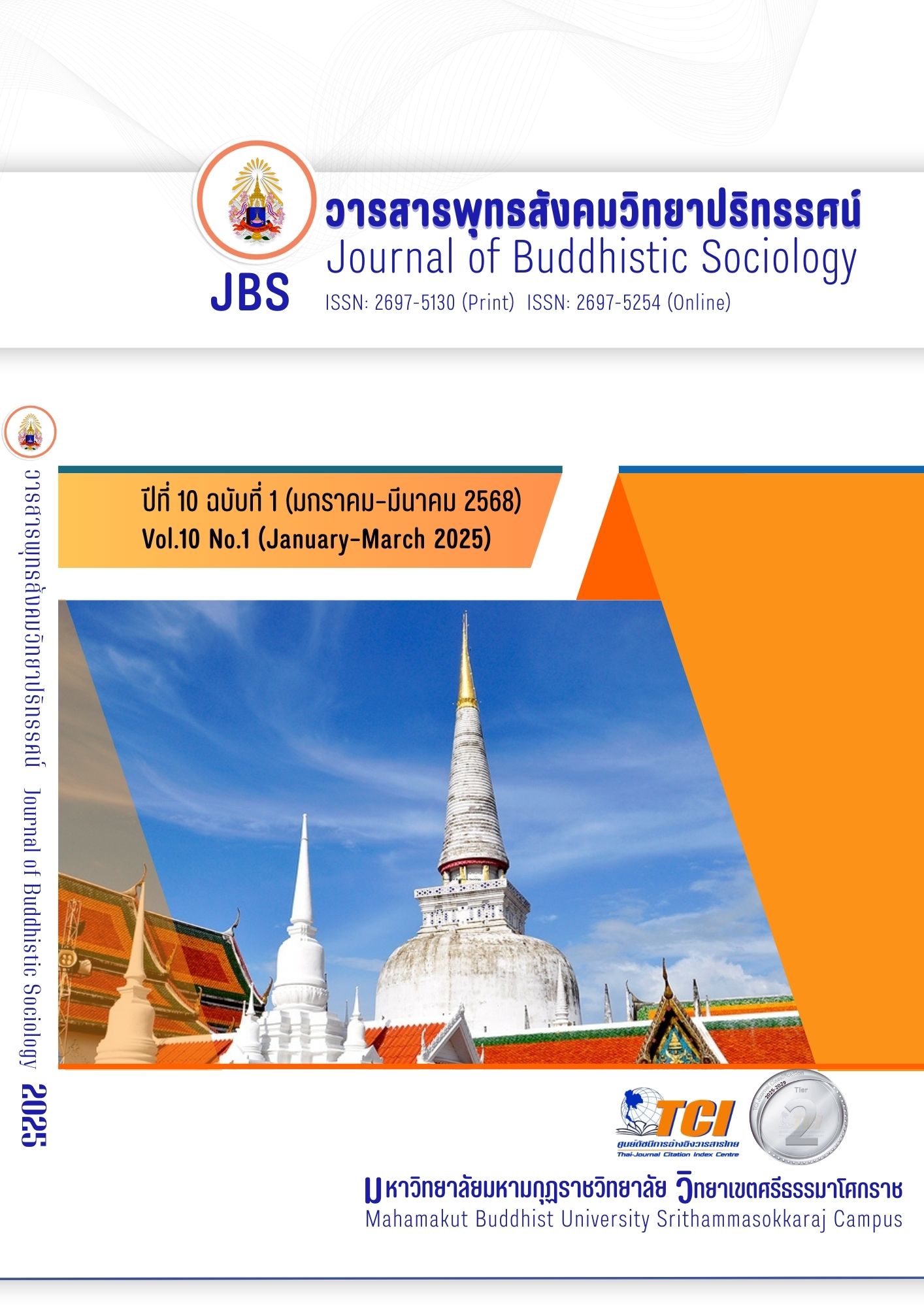THE EVALUATION OF CREATIVE TECHNOLOGY MEDIA DEVELOPMENT, WATPRAMAHATHART SCHOOL GROUP UNDER NAKHON SI THAMMARAT PRIMARY EDUCATIONAL SERVICE AREA OFFICE 1
Main Article Content
Abstract
This quantitative research aimed to evaluate the guidelines for the "Creative Tech Media and Visual Arts Development" project at Wat Phra Mahathat School, which falls under the Nakhon Si Thammarat Primary Educational Service Area Office 1. The study utilized the CIPP Model evaluation framework, focusing on context, input factors, process, and output. The sample group comprised 205 participants, including administrators, teachers, and students. To gather data, a five-point Likert scale opinion questionnaire was used as the evaluation tool. The data analysis involved calculating the mean and standard deviation and performing content analysis.
The research findings:
Indicated a high overall level of effectiveness, with specific evaluation results as follows:
- Overall, the context was high. The project's implementation method was systematic and could be completed on schedule, achieving the highest average value. However, stakeholder involvement in setting objectives and implementation methods received the lowest average score.
- The overall input was high. The activities were appropriate and aligned with the project objectives, yielding the highest average scores. The teaching materials used were modern and well-suited to current social conditions. However, the aspect related to alignment with the national education development strategy received the lowest average score.
- The overall process was of the highest quality. The evaluation results, which were utilized for continuous improvement and development of the project, achieved the highest average score. However, the activities conducted under the project plan at each step had the lowest average value.
- The product achieved the highest overall level. Students in the art subject group demonstrated the highest average academic achievement. However, the organization of learning activities that utilized creative technology media aimed to help students build knowledge and understanding independently had the lowest average performance.
Article Details

This work is licensed under a Creative Commons Attribution-NonCommercial-NoDerivatives 4.0 International License.
References
กระทรวงศึกษาธิการ. (2558). ความก้าวหน้าปฏิรูปการศึกษาในการขับเคลื่อนการปฏิรูปการศึกษา ของกระทรวงศึกษาธิการ. เรียกใช้เมื่อ 28 ธันวาคม 2565 จาก https://www.moe.go.th/moe/th/news/.
______. (2559. แผนพัฒนาการศึกษาของกระทรวงศึกษาธิการ ฉบับที่ 12 (พ.ศ. 2560-2564). กรุงเทพมหานคร: สำนักงานปลัดกระทรวงศึกษาธิการ.
______. (2560). หลักสูตรการศึกษาขั้นพื้นฐาน (พิมพ์ครั้งที่ 1). กรุงเทพมหานคร: โรงพิมพ์ชุมนุมสหกรณ์การเกษตรแห่งประเทศไทย.
กวินธร รัฐอาจ. (2559). การพัฒนารูปแบบการเรียนการสอนแบบห้องเรียนกลับด้านด้วยคลังรายวิชาออนไลน์แบบเปิด. วารสารศึกษาศาสตร์ มหาวิทยาลัยมหาสารคาม, 10(พิเศษ), 68-69.
ชนิศกานต์ ลภะวงศ์. (2556). การประเมินโครงการพัฒนาโรงเรียนขนาดเล็กต้นแบบการจัดการเรียนการสอน แบบคละชั้นของสำนักงานเขตพื้นที่การศึกษาจันทบุรี เขต 1. ใน วิทยานิพนธ์ครุศาสตรมหาบัณฑิต สาขาวิชาการบริหารการศึกษา. มหาวิทยาลัยราชภัฎรำไพพรรณี.
ปนัดดา วงค์จันตา. (2563). การพัฒนาแนวทางการส่งเสริมความสามาถทางศิลปะสำหรับนักเรียนที่มีความบกพร่องทางการได้ยิน โรงเรียนเศรษฐเสถียรในพระราชูปถัมภ์. วารสารวิจัยและพัฒนาการศึกษาพิเศษ, 9(2), 16-28.
สำนักงานเขตพื้นที่การศึกษาประถมศึกษานครศรีธรรมราช เขต 1. (2565). รายงานสรุปผลการดำเนินงานสถานศึกษาในสังกัด สำนักงานเขตพื้นที่การศึกษาประถมศึกษานครศรีธรรมราช เขต 1 ประปีการศึกษา 2563-2655. นครศรีธรรมราช: สำนักงานเขตพื้นที่การศึกษาประถมศึกษานครศรีธรรมราช เขต 1.
สำนักเลขาธิการสภาการศึกษา. (2559). กรอบทิศทางแผนการศึกษาแห่งชาติ พ.ศ. 2560-2574. กรุงเทพมหานคร: สำนักเลขาธิการสภาการศึกษา.
อริยพร คุโรตะ (2561). การพัฒนามาตรฐานหลักสูตรและการสอนสาขาวิชาศิลปศึกษา ระดับปริญญาบัณฑิต ในประเทศไทย. กรุงเทพมหานคร: จุฬาลงกรณ์มหาวิทยาลัย.
อำไพ ตีรณสาร. (2559). วิธีการสอนศิลปะศึกษา. เรียกใช้เมื่อ 28 ธันวาคม 2565 จาก http://pioneer.netserv.chula.ac.th/~tampai1/ampai/cont3.htm
เอกอมร ภัทรกิจพงศ์. (2564). ศิลปะภาพถ่าย: อัตลักษณ์บนเรือนร่าง. ใน วิทยานิพนธ์ ศิลปกรรมศาสตรดุษฎีบัณฑิต. คณะศิลปกรรมศาสตร์. จุฬาลงกรณ์มหาวิทยาลัย.
Arts Education Partnership and National Association of Elementary School Principals. (2018). What school leaders can do to increase arts education. Denver. CO: Arts Education Partnership.
ARTSEDGE. (2018). Arts Education Is a Gateway to Your Child’s Future: High School Learn how to support your child in the arts at school. Retrieved April 8, 2018, From https://artsedge.kennedy-center.org/families/at-school/cae/high-school.
Caldwell, B., & Vaughan, T. (2012). Transforming education through the arts. New York: Routledge.
Haroutounian, J. (2014). Arts talent ID a frame work for the Identification of talented students in the arts. New York: Royal Fireworks Publishing.
Hope, E.W. (2009). Meeting the Needs of Talented Artists in Elementary School. Retrieved September 9, 2022, form http://www.moe.go.th/moe/upload/
news20/FileUpload/41611-3669. pdf
National Art Education Association. (2016). NAEA strategic vision. (2015-2020). Alexandria. VA: National Art Education Association.
Ontario Ministry of Education. (2009). The Ontario Curriculum, Grades 1-8: The Arts. Toronto. ON: Queen’s Printer for Ontario.
Preston, T. (2018). How to Increase Arts Education. Arlington VA: Phi Delta Kappan.
Seifter, H., & Ted B. (.2010). Special issue: Creatively intelligent companies and leaders: Arts-based learning for business. Journal of Business Strategy, 31(4), 8-20.
Stufflebeam, D.L. and Sinkfield, A.J. (2007). Evaluation Theory, Models and Applications.San Francisco. CA: John Wiley and Sons.Inc.
The National Art Education Association. (2012). NAEA Research Commission’s research vision statement. Alexandria. VA: National Art Education Association.
Upitis, R. (2011). Arts Education for the Arts Education for the Development of the Whole Child. Toronto, Elementary Teachers’ Federation of Ontario.
Weinberger, D. (2011). Too Big to Know. NY: Basic Books.


